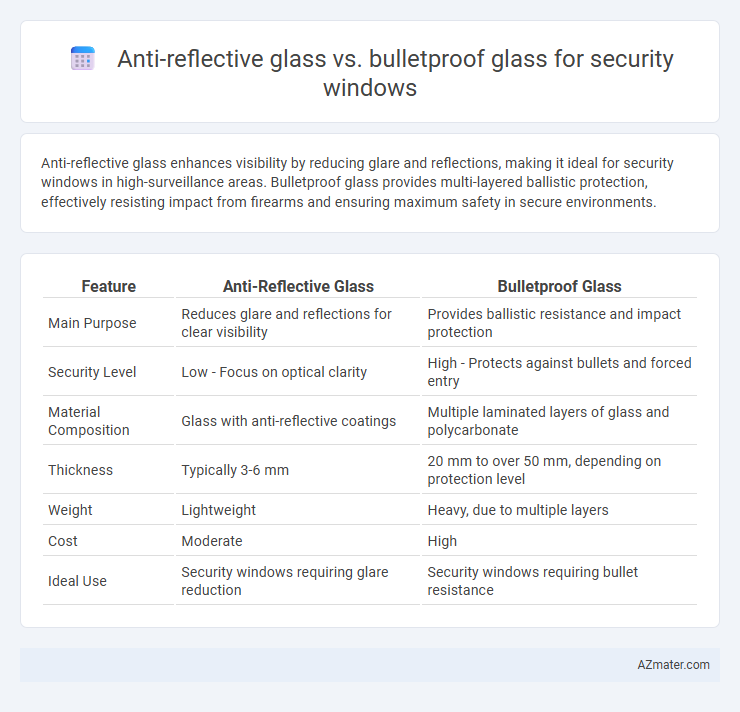Anti-reflective glass enhances visibility by reducing glare and reflections, making it ideal for security windows in high-surveillance areas. Bulletproof glass provides multi-layered ballistic protection, effectively resisting impact from firearms and ensuring maximum safety in secure environments.
Table of Comparison
| Feature | Anti-Reflective Glass | Bulletproof Glass |
|---|---|---|
| Main Purpose | Reduces glare and reflections for clear visibility | Provides ballistic resistance and impact protection |
| Security Level | Low - Focus on optical clarity | High - Protects against bullets and forced entry |
| Material Composition | Glass with anti-reflective coatings | Multiple laminated layers of glass and polycarbonate |
| Thickness | Typically 3-6 mm | 20 mm to over 50 mm, depending on protection level |
| Weight | Lightweight | Heavy, due to multiple layers |
| Cost | Moderate | High |
| Ideal Use | Security windows requiring glare reduction | Security windows requiring bullet resistance |
Introduction to Security Window Solutions
Security window solutions encompass a variety of glass types designed to enhance safety and functionality. Anti-reflective glass reduces glare and improves visibility, making it ideal for environments requiring clear vision and minimal reflection. Bulletproof glass, composed of multiple laminated layers, provides high-impact resistance and protection against ballistic threats, prioritizing security in high-risk areas.
What is Anti-Reflective Glass?
Anti-reflective glass is specially designed to minimize glare and reflections by using multiple thin coating layers that enhance light transmission, improving visibility through security windows. Unlike bulletproof glass, which emphasizes impact resistance and ballistic protection through laminated layers of polycarbonate and glass, anti-reflective glass optimizes optical clarity for surveillance and aesthetic purposes. This glass type is essential in security settings where clear observation without distortion or reflection interference is critical for monitoring and safety.
What is Bulletproof Glass?
Bulletproof glass, also known as ballistic glass, is a strong and transparent material designed to resist penetration from bullets and other high-velocity projectiles, providing enhanced protection in security windows. It consists of multiple layers of laminated glass and polycarbonate, engineered to absorb and disperse the energy of impacts, preventing shattering and maintaining visibility. Unlike anti-reflective glass, which reduces glare and improves clarity, bulletproof glass prioritizes high-level security and durability for environments requiring safety against ballistic threats.
Key Differences: Anti-Reflective vs Bulletproof Glass
Anti-reflective glass reduces glare and enhances visibility by minimizing light reflection, making it ideal for improving clarity in security windows. Bulletproof glass combines multiple layers of laminated glass and polycarbonate to resist high-velocity impacts and provide protection against ballistic threats. While anti-reflective glass prioritizes optical performance, bulletproof glass focuses on durability and safety, making the choice dependent on security needs and environmental conditions.
Security Benefits of Anti-Reflective Glass
Anti-reflective glass enhances security windows by reducing glare and improving visibility, allowing for clearer surveillance and quicker threat detection. Its ability to minimize reflections helps prevent potential intruders from using reflections to their advantage, ensuring higher situational awareness. This glass type also maintains structural integrity while contributing to a safer, more secure environment without compromising light transmission.
Security Benefits of Bulletproof Glass
Bulletproof glass provides superior security benefits for windows by offering high resistance to ballistic threats, preventing penetration from bullets and blunt force impacts that anti-reflective glass cannot withstand. Its multi-layered construction absorbs and disperses energy from attacks, significantly enhancing protection against forced entry and violent incidents. This makes bulletproof glass an essential choice for critical security applications such as banks, government buildings, and secure facilities.
Cost Comparison: Anti-Reflective and Bulletproof Glass
Anti-reflective glass generally costs between $20 to $40 per square foot, making it a more affordable option for enhancing visibility and reducing glare in security windows. Bulletproof glass, however, ranges from $50 to $100 or more per square foot due to its multi-layer construction designed to withstand high-impact forces. The significant price difference reflects the advanced protective properties of bulletproof glass compared to the functional benefits of anti-reflective coatings.
Installation and Maintenance Considerations
Anti-reflective glass requires precise coatings applied during manufacturing to ensure clarity and reduce glare, making installation highly dependent on professional handling to avoid damaging the thin layers. Bulletproof glass demands careful fitting within reinforced frames to maintain its structural integrity and protective capabilities, often resulting in heavier and more complex installation processes. Maintenance for anti-reflective glass involves gentle cleaning with non-abrasive solutions to preserve coatings, whereas bulletproof glass requires regular inspections for cracks or damage that could compromise security.
Best Applications for Each Glass Type
Anti-reflective glass is ideal for security windows in environments requiring maximum visibility and minimal glare, such as retail stores, museums, and control rooms, enhancing surveillance and display clarity. Bulletproof glass excels in high-risk areas like banks, government buildings, and military facilities, providing robust protection against ballistic threats and forced entry. Choosing between the two depends on whether priority is placed on transparent visibility or enhanced physical security.
Choosing the Right Glass for Maximum Security
Anti-reflective glass enhances visibility and reduces glare, making it ideal for security windows where clear observation is essential. Bulletproof glass, typically composed of layered polycarbonate and laminated glass, provides high resistance against ballistic threats and forced entry attempts. Selecting the right glass for maximum security depends on balancing the need for optical clarity with the level of protection required against potential impacts or attacks.

Infographic: Anti-reflective glass vs Bulletproof glass for Security window
 azmater.com
azmater.com